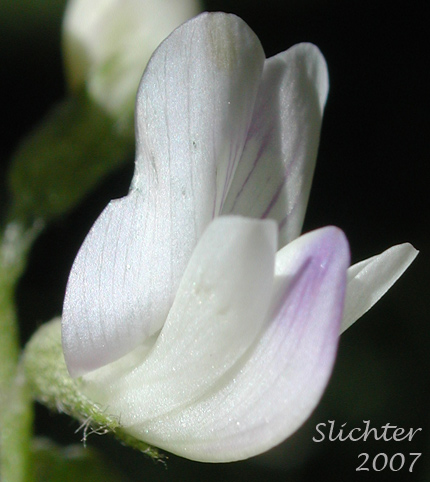
 The
photo at right shows a close-up frontal view of the flower of alpine milk-vetch as seen
in open woods near Irondyke Campground along the Lostine River in the Wallowa-Whitman
N.F.........July 8, 2007.
The
photo at right shows a close-up frontal view of the flower of alpine milk-vetch as seen
in open woods near Irondyke Campground along the Lostine River in the Wallowa-Whitman
N.F.........July 8, 2007.
Also known as Wallowa milk-vetch , alpine milk-vetch is a weak perennial wildflower with spreading stems from 5-30 cm long. The pinnately compound leaves are 2.5-11 cm long with 13-25 lanceolate to elliptic or obovate leaflets from 7-14 mm long The thin and soft leaflets are covered with long, soft, straight hairs on their ventral surface.
The erect flower stems are generally longer than the leaves and are topped by closely flowered racemes of 7-20 spreading flowers. The bell-shaped calyx is covered with black hairs and is 3-4 mm long with awl-shaped teeth up to 2 mm long. The corolla is white with the tips of the banner and keel tinged with lavender while the narrow wings are solidly white (Note photo above.). The banner and keel are about 7.5-13 mm long and the wings are shorter than the keel. The keel is abruptly incurved from 75-90¾ at the tip. The pendulous pods are obliquely ellipsoid, straight, or slightly incurved and measure 7-14 mm long and 2.5-4 mm wide. The pods appear heart-shaped in cross-section and are covered with numerous black or black and white hairs.
Alpine milk-vetch may be found on lake shores, streambanks, cool open woodlands or mountain meadows. It is found near sea level in the Arctic and up to 3400 meters in the Rocky Mts.
Alpine milk-vetch may be found over much of boreal North America. It is found in the Wallowa Mts. of northeastern Oregon and eastward to the mountains of southeastern Idaho and into South Dakota. It is found south through the Rocky Mts. to New Mexico. It is also found in Elko County Nevada, Grand County, Utah and in the Wasatch Mts. in Salt Lake County, Utah.